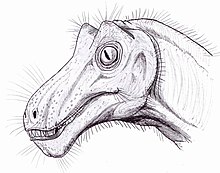Therapsida
| Therapsids Temporal range: Early Permian - Early Cretaceous (non-mammalian)
| |
|---|---|

| |
| Illustration of Pristerognathus, a therocephalian therapsid | |
| Scientific classification | |
| Kingdom: | |
| Phylum: | |
| Subphylum: | |
| Superclass: | |
| Class: | |
| Order: | Therapsida * Broom, 1905
|
| Clades | |
| |
Therapsids, previously known as the "mammal-like reptiles", are an order of synapsid dinosaurs. Traditionally, synapsids were referred to as reptiles. However, when the term is used cladistically, the taxon also includes the mammals, which are descended from the cynodont therapsids.
Characteristics
Therapsids' temporal fenestrae were larger than those of the pelycosaurs[citation needed],. The jaws of therapsids were more complex and powerful and the teeth were differentiated into frontal incisors for nipping, large lateral canines for puncturing and tearing, and molars for shearing and chopping food. Therapsids' legs were positioned more vertically beneath their bodies than were the sprawling legs of reptiles and pelycosaurs.
Evolutionary history

Therapsids' evolutionary track began in the Early Permian, when a group of pelycosaurs, the Sphenacodontia, a lineage that gave rise to Dimetrodon and its family, gave rise to therapsids[citation needed]. Evidence was their anatomical features such as the skull, and the vertebrae. Therapsids became the dominant land animals in the Middle Permian, replacing the pelycosaurs who were becoming rare as Permian period progressed. Therapsida consists of three major clades, the dinocephalians, the herbivorous anomodonts and the mostly carnivorous theriodonts, with the carnivorous biarmosuchians as a paraphyletic assemblage of primitive forms. After a brief burst of evolutionary diversity, the dinocephalians died out in the later Middle Permian (Guadalupian) but the anomodont dicynodonts and the theriodont gorgonopsians and therocephalians flourished, being joined at the very end of the Permian by the first cynodonts[citation needed].
Like all land animals, the therapsids were seriously affected by the Permian-Triassic extinction event, with the very successful gorgonopsians dying out altogether and the remaining groups, dicynodonts, therocephalians and cynodonts of a few species, each surviving into the Triassic[citation needed]. The dicynodonts, now represented by a single family of large stocky herbivores, the Kannemeyeridae, and the medium-sized cynodonts (including both carnivorous and herbivorous forms), flourished worldwide, throughout the Early and Middle Triassic. They died out across much of Pangea at the end of the Carnian (Late Triassic), although they continued for some time longer in the wet equatorial band and the south.

Some exceptions were the still further derived eucynodonts. At least three groups of them survived. They all appeared in the Late Triassic epoch.
- The extremely mammal-like family, Tritylodontidae, survived into the Early Cretaceous.
- An extremely mammal-like family, Tritheledontidae, are unknown later than the Early Jurassic.
- The third group, Morganucodon and similar animals, were mammaliformes or the "stem-mammals".
Some non-eucynodont cynodonts survived the Permian-Triassic extinction, such as Thrinaxodon but only to become extinct by the Middle Triassic.
The therocephalians, relatives of the cynodonts, managed to survive the Permian-Triassic extinction and continued to diversify through Early Triassic epoch. Approaching the end of the epoch, however, the therocephalians were declining to extinction and eventually became extinct, possibly due to climatic changes and competition from cynodonts and other animals struggling to survive.
Dicynodonts are thought to have become extinct before the end of the Triassic, but there is evidence that they survived the extinction. Their fossils have been found in Gondwana. Other animals that were common in the Triassic also took refuge here, such as the Temnospondyls. This is an example of Lazarus taxon[citation needed].
Mammals, the only living therapsids, evolved in the Early Jurassic epoch. They radiated from a group of mammaliaformes that is related to the symmetrodonts. The mammaliaformes themselves evolved from probainognathians, a lineage of the eucynodont suborder.
Taxonomy
Classification






- Class Synapsida
- ORDER THERAPSIDA *
- Suborder Biarmosuchia *
- Family Biarmosuchidae
- Family Eotitanosuchidae
- Eutherapsida
- Suborder Dinocephalia
- Family Estemmenosuchidae
- Anteosauria
- Family Syodontidae
- Family Brithopodidae
- Family Anteosauridae
- Tapinocephalia
- Family Titanosuchidae
- Family Tapinocephalidae
- Neotherapsida
- Suborder Anomodontia *
- Superfamily Venyukoviamorpha
- Family Venyukoviidae
- Infraorder Dicynodonta
- Superfamily Venyukoviamorpha
- Theriodontia *
- Suborder Gorgonopsia
- Family Gorgonopsidae
- Eutheriodontia
- Suborder Therocephalia
- Suborder Cynodontia *
- (unranked) Mammaliformes *
- Suborder Gorgonopsia
- Suborder Anomodontia *
- Suborder Dinocephalia
- Suborder Biarmosuchia *
- Class Mammalia
Phylogeny
Synapsida | Sphenacodontia |-Sphenacodontidae `-Therapsida |-?Tetraceratops `-+-Biarmosuchia | |-Eotitanosuchidae | `-?Phthinosuchidae `-Eutherapsida |-Dinocephalia | |-Anteosauria | `-Tapinocephalia `-Neotherapsida |-Anomodontia | |-Dromasauria | `-Dicynodontia `-Theriodontia |-Gorgonopsia | |-Lycaenops | `-Inostrancevia `-Eutheriodontia |-Therocephalia | `-Eutherocephalia | `-Bauria `-Cynodontia `-Mammalia
See also
- Mammal-like reptile
- Dinosaurs - therapsids' evolutionary counterparts
External links
- "Therapsida: Mammals and extinct relatives". Tree of Life.
- "Therapsida: overview". Palaeos.
- "Therapsids in Detail". Stephen Priestley - Illustrator
References
- Kemp, T.S. (2005): The origin and evolution of mammals. Oxford University Press
- Benton, M.J. (2004): Vertebrate Paleontology. 3rd ed. Blackwell Science Ltd
- Carroll, R.L. (1988): Vertebrate Paleontology & Evolution. W.H. Freeman & Company, NY
- Romer, A.S. (1966): Vertebrate Paleontology. University of Chicago Press, 1933; 3rd ed.
